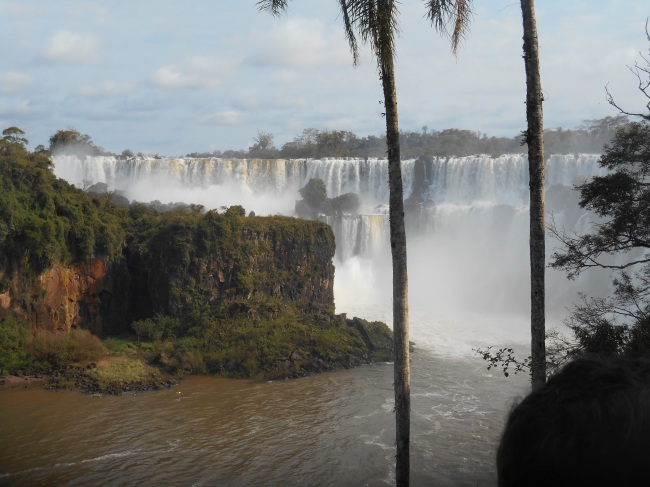
My trip to Iguazú falls started in the exact same way as all my other weekend excursions here in Argentina: a comfortable seat in the upper level of a coach bus, fully loaded backpack at my feet, and butterflies in my stomach. If someone were to look closely, however, they would notice a few differences that gave a clue as to the nature of this trip. First, I had splurged this time and upgraded to a cama seat in place of the usual semi-cama. The ride to the Missiones section of Argentina, a little finger of land that juts into the heart of Brazil, takes about 16 hours, and I figured they might as well be a comfortable 16 hours. Second, instead of being accompanied by a lone amigo, I was surrounded by 5 other wonderful people from my program. Becky and Jess had been previous companions (to Tapalque and Mendoza, respectively), but it was my first trip with Marrisca, Matt, and Katie. The 6 of us had planned, booked, and built up the trip together, and now we were ready to take Iguazú by storm. Finally, my backpack was slightly lighter than on previous trips; shorts, t-shirts, and a swimsuit had taken the place of jeans and jackets. Puerto Iguazú sits in the far north of Argentina, and rumor had it that it could get pretty warm up there.
If he let his gaze linger for a little longer, the casual observer also might notice that our group possessed a quiet comfortability of those that have traveled before. Sure, it’s only been about two months, but all of us had been on at least one extended weekend trip, and navigated the craziness of Buenos Aires besides. There was a little less “oohing” and “ahhing” at the reclining seats, a more systematic approach to stowing our gear, and most of has made the veteran decision to bring a freshly toasted Subway sandwich for dinner. I’m not proud that I supported the American chain, but I can tell you that in a culture where “to go” food is very limited, fresh veggies and honey mustard between freshly baked bread tasted pretty darn good.
The bus pulled out of Retiro station at 8:40pm, and the group, divided into three rows of two, filled our corner of the bus with the happy buzz of conversation. My neighbor for the voyage was Katie Mercer, a fellow Vermont-based student (she goes to UVM), who shares my passion for preparing and enjoying good food. We passed the night swapping stories and life philosophies, joined at times by Matt and Marrisca, who were seated behind us. Before I knew it, my watch read 1:00, and I found myself drifting to sleep, lulled by Matt’s voice painting a picture of his future “Southern belle” wife.
Waking up from a good nights sleep on a moving bus is not anywhere near as odd as you might think. There is something magical about being “in transit,” a feeling of possibility that comes from moving towards a new place, towards new adventures. Now almost 12 hours into the trip, the landscape was beginning to give a clue as to where we were going. The expansive grasslands of the Pampas faded into slight hills, speckled with various types of trees. As we continued north, the vegetation flushed out; dense, deep green walls lined the road, in stark contrast with the red clay soil and cotton-candy blue sky. It felt like…well, it felt like the jungle.
Our bus pulled into the terminal in Puerto Iguazú at 12:30pm Friday afternoon, capping off a 16 hour voyage filled with good talks, deep thoughts, sweet dreams, and beautiful scenes. We emerged into the bright sunlight, blinking away leftover drowsiness and taking stock of our new surroundings. Instead of the bustling, tourist-filled town that I had imagined, Puerto Iguazú looked like a place where you could pass 10 or 20 years without really noticing a difference. Simple, brightly colored houses lined roads populated with old mopeds and motorbikes. Signs showing various states of aging advertised parillas, pizza restaurants, taxi services, and small supermarkets. Maybe it was just the heavy, warm rays of the sun, but I felt as if an invisible pressure dictated that here, everything moved at half speed.
Keeping with that easygoing pace, our group coasted two blocks down the hill from the bus terminal and through the front doors of the Timbo Posada Hostel, a bright yellow building tucked into the side of one of the “main” streets of the city. There were 6 of us in a room of 8, and with only one other bed occupied, it felt like we were all part of a classic high school slumber party. A quick walk through the rest of the hostel led us to its crowning jem- a secluded patio, complete with hammock, pool, and towering greenery. In the rear was an open-air dining room and kitchen that looked like something out of Bahamas Housekeeping magazine: handmade wooden tables, chairs, cupboards, and a small bar complemented a full kitchen with a large window that offered a few of the sunbaked patio. I probably could have passed the weekend right there without feeling the least bit bothered, but we had our world traveler duties to attend to.
After giving the appropriate amount of “oohs,” “ahhs,” and “can you believe it?’s,” our group set off down the street towards Las Tres Fronteras. Our program director, Carmen, had told us about the picturesque spot where two rivers met at a right angle, dividing the countries of Argentina, Brazil, and Paraguay (hence the name “three borders”). The half-speed pressure of the innocent little town was still a strong presence, so we enjoyed meandering through the quiet streets, guided by the falling sun. The timing couldn’t have been better. We arrived at the lookout for tres fronteras just in time for one of the most beautiful sunsets I’ve had the pleasure to enjoy, rivaling even those seen of Mt. Washington from across Highland Lake. Matt, Marrisca, Katie, Jess, Becky, and I watched while leaning against the fence on the Argentine side of the divide. To the left was the red, white, and blue marker of Paraguayan border, and directly in front of us, 100 yards across the river, was the yellow and green of Brazil. Meanwhile, on the border of the horizon, the sky went through it’s own spectrum of colors. Yellow, orange, red, purple, navy, and midnight blue bled into one another until the stars stood out against an inky black sky. It was spectacular, a work of art you can’t find in any museum.

On the border with the whole crew
With our sense of sight happily satisfied, the next thing we had to attend to was our taste buds. Earlier in the day we had planned out and bought ingredients for a tropical dinner of our own creation, waiting for us back at the hostel. I hopped behind the counter in our open air kitchen to put together a chicken/vegetable stir fry over brown rice. Meanwhile, Katie took over the responsibility of creating a fresh mango salsa to garnish. Looking at the finished product, you would have thought we had stolen some of the colors from the sunset to put on our plates, and I’ll be the first to say it tasted as good as it looked: Crisp, crunchy, bright, sweet, and utterly delicious. Top it off with an ice cream sundae from a local heladería, some late night conversation, and the result is a sound nights sleep with all of my senses completely satisfied.
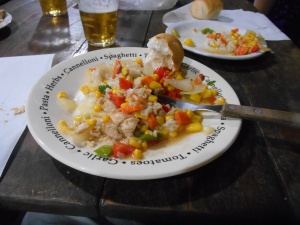
…Followed by dinner
The next day, Saturday, was our “business” day in Iguazú. We had come to see the falls, and we were going to do it right. That meant a 7:30 wakeup call to 90’s classic music, followed by a hearty breakfast of coffee, fresh baked break, homemade cake, and fresh-squeezed OJ. One 20-minute taxi ride later, and we were standing at the entrance to Iguazú National Park by 10:00 (like I said, everything moves at half speed here).
Unfortunately, the morning had greeted us with gray skies and intermittent drizzle, but we had come prepared with rain jackets, ponchos, swimsuits, bright smiles, and the delighted energy that comes from traveling with new friends. We wound through jungle vegetation with high spirits and boarded a miniature train towards the park’s main attraction: La Garganta del Diablo. The name, which means “Devil’s Throat,” is given to the largest, most powerful section of the falls, and it is the spot in the park which gets you closest to the action.
We got off the train and joined the steady stream of people shuffling across an enormous metal boardwalk. Built upon thick concrete supports, it stretches for over a kilometer across the river that leads to Iguazú falls. Joining the thrum of people, I still didn’t really feel like I was about to see one of the 7 natural wonders of the world. As we continued across a dull roar began to build, and with it, my excitement. We passed visitors going the other direction, looking like they had jumped into the river instead of walked across it. With a mere 500 feet left to go, the roar became a palpable presence, and I could see columns of vapor rising in front of me. An Argentine flag flapped madly in the wind and rain, adding to the tension of the scene. More than anything, I wanted to see the source of all this noise, to understand if it was truly worth all of the attention. Finally, we came close enough to see the river in front of us drop into nothingness. Across from the edge of the boardwalk, a mere 30 feet way, was a frothing wall of cascading water, and endless torrent that disappeared into oblivion, swallowed up by the vapor it created as it crashed into the river below.
I stood stock-still for an easy 5 minutes, eyes clenched against the combination of wind, rain, and recycled vapor that swept by me. I have seen many natural creations that take my breath away: towering mountains, sweeping valleys, stretches of ocean, but this was different. It wasn’t the size, or the proximity, but the movement that drew my attention. Impossible amounts of water swept ceaselessly downward, creating an ever-changing spectacle that could capture the eyes and the imagination. Not only that, but the noise, wind, and vapor created gave this landform a sense of life that is absent in others. It was unlike anything I had seen before.
Shaking off the awe from La Garganta, and retreating from the battering wind and rain, our group retraced our steps back across the boardwalk. Next on the day’s itinerary was a scenic trip down the river that would bring us roughly back to where we had started the day. We piled into an inflatable orange raft with a few other turistas and passed a peaceful 20 minute ride hearing about the local flora and fauna from our guide, Juan. Thanks to a stroke of luck, we got the chance to have an up-close encounter with an Argentine alligator, lounging on one of the banks without a care in the world. I guess that’s what comes from being at the top of the food chain.
By the time we landed safely downriver it was 1:30 and our stomachs were reminding us that Argentine breakfasts, although delicious, don’t last forever. We found seats and cheap eats inside a little food court just in time to dodge the largest downpour of the day. The sky opened up and soaked those walking by, while I happily munched on a ham, cheese, lettuce, and tomato sandwich that really wasn’t that bad, made tastier by the fact that I was warm, dry, and surrounded by good friends.
We made short work of lunch and, as if on cue, the sun began to burn through the layer of gray clouds that had persisted since morning. I felt as if I was the subject of one of those “Claritin Clear” commercials, as if somebody had peeled back a veil to show the true colors of the world: tropical greens, yellow sun, blue sky, and strange flowers in all manner of pastel hues. We set off down a new path into what looked as if it could have been a new day, weaving past rushing waterfalls and scenic vistas underneath a sunlit jungle canopy. It wasn’t until we arrived at the first lookout, however, that I truly realized what a gift this new day was.
Spread out in front me was an enormous, panoramic view of the entire stretch of Iguazú falls. Over a dozen individual waterfalls frothed with falling water, suspended in the air before crashing down into the river to follow a course lined with sheer cliffs. Tropical birds careened across the abyss, euphoric with their power of flight. The newly-emerged sun was the clincher, illuminating the entire scene as if it were a movie set. Huge, arcing rainbows formed as the individual rays met with airborne water vapor. If La Garganta defined powerful, this view defined beautiful.
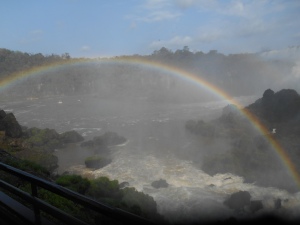
These kind of places exist?
By this point I felt like I knew Iguazú Falls pretty well. I had gotten battered by the sheer force of La Garganta and passed through at least 5 lookouts that took my breath away. There really was only one option left: get up close an personal, that is to say, get wet. Upon first entering the park, Matt, Katie, Jess, Becky, Marrisca, and I had all paid for a 4:00pm appointment with a boat that brought you within spitting distance of both sides of the falls. Trust me when I say that it was every bit as intense as you can imagine.
Upon boarding we were outfitted with life jackets and handed individual dry bags to stow our shoes, money, phones, cameras, and anything else that we didn’t want to be absolutely soaked. Our little jetboat took off towards the base of the falls, weaving and bouncing around the waves tossed up by crashing water. With an extra burst, the pilot sent us into the shroud of mist, where we were met by a bone-shaking roar and gallons upon gallons water being showered upon our little boat. I added my own voice to the hoots and hollers of the other passengers, reveling in the all-natural shower. After about 45 seconds we came out of the chaos sopping wet, but otherwise unscathed, only to shoot off towards the other end of the falls, where we repeated the experience. In between shielding my eyes against the torrent and spitting out mouthfuls of fresh Iguazu-an water I realized that now, I truly knew the falls.
Our little boat coasted safely back into port where we disembarked, leaving puddles behind us. It was just about 5:00, we were soaking wet, and the park was closing in our. Nevertheless, we had one more scenic loop that still remained undiscovered. Refusing to let a little water stop us, the group pushed back our wet hair and set off along the final path. The falling sun cast a golden light upon the entire park, drying our backs and showing yet another breathtaking perspective of the falls that seemed to whisper “peace.”
Our group landed back in Puerto Iguazú around 7:00 Saturday night. A round of tea and hot showers gave us the energy to go out and enjoy some outdoor fajitas a local Mexican joint, owned by a delightful gentleman named Miguel. Unable to pass up the $15 peso (<$2 dollar) ice cream sundaes, we returned to the same heladería to cap off one of the most amazing days in Argentina.
For the sake of time, my reader’s eyes, and my well-worked fingers, I’ll turn to a quick summary for our remaining 14 hours in Iguazú. Suffice it to say they were just as much fun as the previous 2 days. Ice cream was followed by late-night conversation over a bottle of wine at the hostel. On Sunday, I managed to convince everybody that another 7:30 wakeup was a good idea, as it gave us the opportunity to check out a local animal reserve before our bus left early that afternoon. The site was a combination conservation, rehabilitation, education project that held all manner of local animals: toucans, monkeys, turtles, guinea pig- pig hybrids, and over 15 different species of birds. That tour left us with just enough time to enjoy a simple lunch and pack up before boarding another Cama bus, this one bound for the city of Buenos Aires. We bid a fond farewell to the sleepy little city of Puerto Iguazú and settled back to recharge the batteries over the 18 hour bus ride, in which deep conversation was matched by a deep sleep.
We were back in Buenos Aires in time for classes on Monday, the warm Iguazú sun and crashing water still echoing in my mind as a sweet reminder of our trip to paradise.
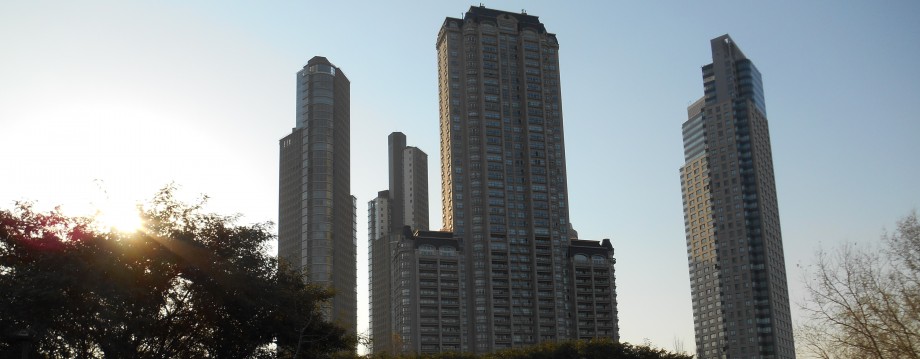




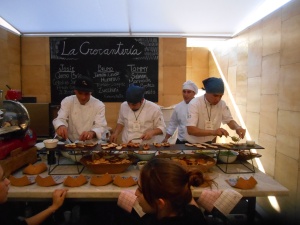

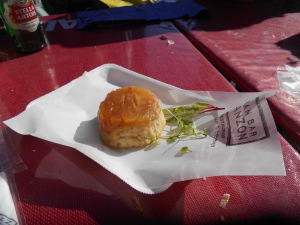



Recent Comments